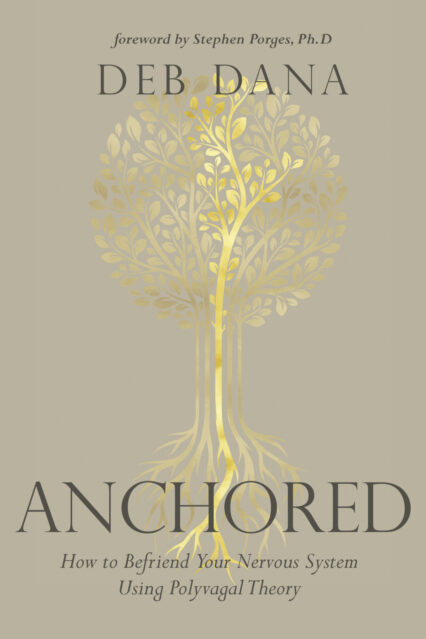Polyvagal Theory expert Deb Dana explores anchoring into your nervous system and connecting to your body’s neural pathways for calmness, safety, and connection.
Polyvagal Theory expert Deb Dana, LCSW, is the developer of the Rhythm of Regulation Clinical Training Series. Her book Anchored: How to Befriend Your Nervous System Using Polyvagal Theory offers a guide to your body’s neural pathways for calmness, safety, and connection. Learn more at rhythymofregulation.com.
S&H: The nervous system is our body’s electrical system, invisible, but it controls nearly everything. What are the benefits of a deep dive into the workings of the nervous system?
Deb Dana: The nervous system is at the heart of our daily experience responsible for helping us navigate the demands of our day. It works in the background, outside of our conscious awareness making moment-to-moment changes to our physiology as we meet each new experience. When we understand how the nervous system works, we can begin to work with it. We can learn to shape our responses in ways that increase our capacity to be regulated and return to regulation when we are pulled into survival energy.
I call this befriending our nervous system and think about it like forming a friendship—first we get acquainted and then we deepen the connection. When we get to know our nervous system, we appreciate the ways it works automatically so we don’t have to attend to each breath and heartbeat. When we partner with our nervous system, we bring awareness to the patterns of connection and protection that have been shaped to serve our safety and explore ways to anchor in regulation.
[Read: “Your Nervous System at War: How to Negotiate Peace.”]
Many of your exercises and meditations begin with a call to conjure up memories of jolts to the nervous system, such as fight, flight, or freeze responses. I felt at a loss to conjure up what are by definition involuntary reactions. Can I really retrieve these feelings on command?
Our memories are stored in our minds and bodies and when we remember a moment, we also return to the autonomic experience that accompanies that moment. As we bring up a memory, the autonomic information associated with that memory comes to life and we feel the physiological changes that activated in that moment.
The call to intentionally bring up a memory that jolted our system is an invitation to revisit the moment and be with it in a new way—to remember with enough regulation to not get hijacked by the survival response held in the memory. And along with memories of challenging moments, we can also return to a memory of ease, savor the memory, and feel nourished by the energy of safety and regulation.
Your book felt like a quiet journey through the nervous system, with a map key and place names in a new dialect. When did you first discover this “map”? How was it different from your prior understanding of the nervous system?
I discovered Polyvagal Theory when I read Stephen Porges’ first book. It was a powerful moment for me—a “before and after” experience that changed the way I work and the way I live. Before finding Polyvagal Theory, I understood the nervous system the way most of us have been taught—as a system that fluctuates between calm and stress. Polyvagal Theory provided an updated understanding of the nervous system describing three parts of the system that work in a predictable order and illustrating how we move between states in an organized way.
Polyvagal Theory gave me a way to map moments of activation, shut down, and regulation and a language to talk about these experiences. As I have become skilled in using an autonomic map and fluent in the language of the nervous system, I navigate the world in a new way. I look for the biology beneath behaviors, my own and others, and listen to the story the autonomic nervous system is telling.
Your writing about self-care felt so nourishing and universally essential. Polyvagal theory aside, how do you encourage and inspire your readers and clients to prioritize self-care?
When I talk to people about self-care the first challenge is to untangle the concept of self-care from beliefs about being selfish. Somehow self-care has become equated with paying attention to our own needs at the expense of others. What many studies have found, and what the airline reminder to put your own mask on first illustrates, is that unless we are nourished in our daily lives, we can’t show up for the people we live with and love in ways that are supportive to them. The benefits of self-care are felt in our physical and psychological wellbeing. We are healthier and happier when we attend to our needs for self-care, and we bring that energy with us as we move through the world. Our commitment to attending to our own wellbeing is also a commitment to being a regulating presence in the world.
Once we are open to the idea of self-care being an essential ingredient in wellbeing, then we need to understand that while self-care is a universal need, it is not a one size fits all experience. It’s easy to get discouraged and think there must be something wrong with us when what works for others doesn’t interest us. We each need to create our own personal self-care menu. I begin by encouraging people to experiment with all sorts of practices and discover what nourishes them.
[Read: “Train Your Brain for Good Habits.”]
The invitation is to be curious and have fun in the process. The goal is not to create a rigid routine but to have a wide range of choices so each day you can sense what your self-care needs are and have a practice you can reach for. Over time, some practices deepen while others are taken off the menu. When we think of self-care as an ongoing adventure, we are inspired to keep exploring.
I loved your invocation of the “micro-community,” people gathered close by to help you on your journey of growth. Can you share with us a story of transformation from your own micro-community?
My life journey has been one of being “independent” or through the lens of the nervous system one of finding protection in dorsal disconnection. Learning that it is safe to reach out and that people will show up has been a big part of my own work. My husband had a stroke seven years ago and in an instant, our lives were forever changed. My lifelong habit of doing everything myself was no longer a viable option and yet I struggled to ask for or accept help. So many kindhearted people reached out with offers of support but instead of feeling cared for I felt overwhelmed.
It was only when the people in my micro-community showed up that I began to feel safe enough to accept help. Because they also speak the language of the nervous system and they know my patterns, they simply came to be with me. I felt their presence without any pressure to say anything or do anything. I felt cared for in just the way I needed and began to see a way forward. Seven years into this new life I am more at ease finding the balance between being on my own and receiving help. While I still lean toward being independent, I have learned to trust the people in my micro-community will be there for me when I do reach out.
Memories, especially ones forged by trauma, live in our bodies both close to the surface and deep in the tissues. What other somatic practices complement polyvagal theory and therapies?
To me, looking through a Polyvagal lens is the foundation for moving into any other kind of work. With any intervention we are offering, any approach to change, whether cognitive or embodied, we are working with the nervous system, and understanding how the system works is the essential first step.
Autonomic awareness gives us a deeper appreciation of the impact of somatic practices. We can track a client’s moment-to-moment response and adjust the practice to engage in the most effective way. The wide range of available somatic practices offers options to support clients in working with past trauma. Understanding the role of the nervous system adds another layer of safety to the process.
Is your work and teaching informed by a spiritual practice or a connection to spirit? Can you share how?
I believe the four pathways of connection—self, other, the world, and spirit—are there for each of us to discover and walk. While I feel solidly connected to self, other, and the world, my connection to spirit is an ongoing exploration. I didn’t grow up in a religious or spiritual family and the spiritual realm remains relatively unexplored territory for me. As I wrote about in the book, in a time of great need, I experienced a powerful moment of connection with Mother Mary and a sense of her presence has stayed with me. I continue to turn toward her in times of need and reach for that energetic connection to remind myself I am not alone. These experiences bring comfort and also curiosity. I am not sure where this is leading and wonder where my journey will take me.
[Read: “Furious to Curious: Listening as a Spiritual Practice.”]
In my work as a therapist, I am much clearer about my connection to spirit. I have always had an embodied knowing that I am working in cooperation with something bigger than myself. It is a humbling experience to sit with others in their suffering and help them find the way forward and I put my trust in the belief that I am not doing this work alone. When I teach and write, I talk about spirit and the many ways spirit can appear. I think we are shaped by the stories of spirit we share so I name the pathway of connection to spirit and invite spirit in with practices and conversations that are welcoming and bring safety to the exploration.
Want more on Polyvagal Theory? Read Deb Dana’s article: “Polyvagal Theory: The Stories We Inhabit.”
Read our review of Anchored.







